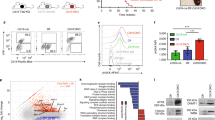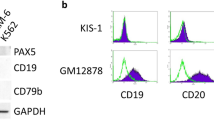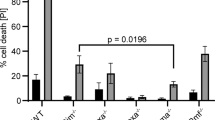Abstract
Bcl-6 is a transcription factor that is normally expressed in germinal centre B cells. It is essential for the formation of germinal centres and the production of high-affinity antibodies. Transcriptional downregulation of Bcl-6 occurs on terminal differentiation to plasma cells. Bcl-6 is highly expressed in B-cell non-Hodgkin's lymphoma and, in a subset of cases of diffuse large cell lymphoma, the mechanism of Bcl-6 overexpression involves interruption of normal transcriptional controls. Transcriptional control of Bcl-6 is, therefore, important for normal antibody responses and lymphomagenesis, but little is known of the cis-acting control elements. This report focuses on a region of mouse/human sequence homology in the first intron of Bcl-6, which is a candidate site for such a control element. We demonstrate that poly-(ADP-ribose) polymerase-1 (Parp-1) binds in vitro and in vivo to specific sequences in this region. We further show that PARP inhibitors, and Parp-1 knockdown by siRNA induce Bcl-6 mRNA expression in Bcl-6 expressing cell lines. We speculate that Parp-1 activation plays a role in switching off Bcl-6 transcription and subsequent B-cell exit from the germinal centre.
This is a preview of subscription content, access via your institution
Access options
Subscribe to this journal
Receive 50 print issues and online access
$259.00 per year
only $5.18 per issue
Buy this article
- Purchase on Springer Link
- Instant access to full article PDF
Prices may be subject to local taxes which are calculated during checkout





Similar content being viewed by others
References
Akiyama T, Takasawa S, Nata K, Kobayashi S, Abe M, Shervani NJ et al. (2001). Activation of Reg gene for insulin producing beta cell regeneration: poly(ADP)-ribose polymerase binds Reg promoter and regulates the transcription by autopoly(ADP)-ribosylation. Proc Natl Acad Sci USA 98: 48–53.
Ame JC, Spenlehauer C, de Murcia G . (2004). The PARP superfamily. Bioessays 26: 882–893.
Amiri KI, Ha HC, Smulson ME, Richmond A . (2006). Differential regulation of CXC ligand 1 transcription in melanoma cell lines by poly(ADP-ribose) polymerase-1. Oncogene 25: 7714–7722.
Bereschenko OR, Gu W, Dalla-Favera R . (2002). Acetylation inactivates the transcriptional repressor Bcl-6. Nat Genet 32: 606–613.
Bernardin F, Collyn-d’Hooghe M, Quief S, Bastard C, Leprince D, Kerckaert J . (1997). Small deletions occur in highly conserved regions of the LAZ3/BCL6 major translocation cluster in one case of non-Hodgkin's lymphoma without 3q27 translocation. Oncogene 14: 849–855.
Borggrefe T, Wabl M, Akhmedov AT, Jessberger R . (1998). A B-cell specific recombination complex. J Biol Chem 273: 17025–17035.
Bross L, Fukita Y, McBlane F, Demolliere C, Rajewsky K, Jacobs H . (2000). DNA double-strand breaks in immunoglobulin genes undergoing somatic hypermutation. Immunity 13: 589–597.
Butler AJ, Ordahl CP . (1999). Poly(ADP-ribose) polymerase binds with transcription enhancer factor 1 to MCAT1 elements to regulate muscle specific transcription. Mol Cell Biol 19: 296–306.
Cattoretti G, Chang C, Cechova K, Zhang B, Ye B, Falini B et al. (1995). BCL-6 protein is expressed in germinal-center B cells. Blood 86: 45–53.
Cervellera MN, Sala A . (2000). Poly(ADP-ribose) polymerase is a B-myb coactivator. J Biol Chem 275: 10692–10696.
Chang C, Ye B, Chaganti R, Dalla-Favera R . (1996). BCL-6, a POZ/zinc-finger protein, is a sequence-specific transcriptional repressor. Proc Natl Acad Sci USA 93: 6947–6952.
Chapman MA, Donaldson IJ, Gilbert J, Grafham D, Rogers J, Green A et al. (2004). Analysis of multiple genomic sequence alignments: a web resource, online tools, and lessons learned from analysis of mammalian SCL loci. Genome Res 14: 313–318.
Chattopadhyay A, Tate SA, Beswick RW, Wagner SD, Ko Ferrigno P . (2006). A peptide aptamer to antagonize BCL-6 function. Oncogene 25: 2223–2233.
Chevallier N, Corcoran CM, Lennon C, Hyjek E, Chadburn A, Bardwell VJ et al. (2004). ETO protein of t(8;21) AML is a corepressor for Bcl-6 B-cell lymphoma oncoprotein. Blood 103: 1454–1463.
D’Amours D, Desnoyers S, D’Silva I, Poirier GG . (1999). Poly(ADP-ribosyl)ation reactions in the regulation of nuclear functions. Biochem J 342 (Part 2): 249–268.
Dent A, Shaffer A, Yu X, Allman D, Staudt L . (1997). Control of inflammation, cytokine expression and germinal centre formation by BCL-6. Science 276: 589–592.
Durkacz BW, Omidiji O, Gray DA, Shall S . (1980). ADP-ribose)n participates in DNA excision repair. Nature 283: 593–596.
Fujita N, Jaye DL, Geigerman C, Akyildiz A, Mooney MR, Boss JM et al. (2004). MTA3 and the Mi-2/NuRD complex regulate cell fate during B lymphocyte differentiation. Cell 119: 75–86.
Gottgens B, Gilbert J, Barton L, Grafham D, Rogers J, Bentley D et al. (2001). Long-range comparison of human and mouse SCL loci: localized regions of sensitivity to restriction endonucleases correspond precisely with peaks of conserved noncoding sequences. Genome Res 11: 87–97.
Gregory CD, Rowe M, Rickinson AB . (1990). Different Epstein-Barr virus-B-cell interactions in phenotypically distinct clones of a Burkitt's lymphoma cell line. J Gen Virol 71 (Part 7): 1481–1495.
Haince JF, Rouleau M, Poirier GG . (2006). Transcription. Gene expression needs a break to unwind before carrying on. Science 312: 1752–1753.
Hassa PO, Covic M, Hasan S, Imhof R, Hottiger MO . (2001). The enzymatic and DNA binding activity of PARP-1 are not required for NF-κB coactivator function. J Biol Chem 276: 45588–45597.
Huang K, Tidyman WE, Le K-UT, Kirsten E, Kun E, Ordahl CP . (2004). Analysis of nucleotide sequence dependent binding of poly(ADP-ribose) polymerase in a purified system. Biochemistry 43: 217–223.
Huber A, Bai P, de Murcia J, de Murcia G . (2004). PARP-1, PARP-2 and ATM in the DNA damage response: functional synergy in mouse development. DNA Repair (Amst) 3: 1103–1108.
Huynh KD, Bardwell VJ . (1998). The BCL-6 POZ domain and other POZ domains interact with the co-repressors N-CoR and SMRT. Oncogene 17: 2473–2484.
Ju BG, Lunyak VV, Perissi V, Garcia-Bassets I, Rose DW, Glass CK et al. (2006). A topoisomerase IIbeta-mediated dsDNA break required for regulated transcription. Science 312: 1798–1802.
Ju BG, Solum D, Song EJ, Lee KJ, Rose DW, Glass CK et al. (2004). Activating the PARP-1 sensor component of the groucho/ TLE1 corepressor complex mediates a CaMKinase IIdelta-dependent neurogenic gene activation pathway. Cell 119: 815–829.
Kikuchi M, Miki T, Kumagai T, Fukuda T, Kamiyama R, Miyasaka N et al. (2000). Identification of negative regulatory regions within the first exon and intron of the BCL-6 gene. Oncogene 19: 4941–4945.
Kim MY, Mauro S, Gevry N, Lis JT, Kraus WL . (2004). NAD+-dependent modulation of chromatin structure and transcription by nucleosome binding properties of PARP-1. Cell 119: 803–814.
Kraus WL, Lis JT . (2003). PARP goes transcription. Cell 113: 677–683.
Lonskaya I, Potaman VN, Shlyakhtenko LS, Oussatcheva EA, Lyubchenko YL, Soldatenkov VA . (2005). Regulation of poly(ADP-ribose) polymerase-1 by DNA structure-specific binding. J Biol Chem 280: 17076–17083.
Ma L, Wortis HH, Kenter AL . (2002). Two new isotype specific switching activities detected for immunoglobulin class switching. J Immunol 168: 2835–2846.
Margalit O, Amram H, Amariglio N, Simon AJ, Shaklai S, Granot Ge et al. (2006). BCL6 is regulated by p53 through a response element frequently disrupted in B-cell non-Hodgkin lymphoma. Blood 107: 1599–1607.
Masson M, Niedergang C, Schreiber V, Muller S, Menissier-de Murcia J, de Murcia G . (1998). XRCC1 is specifically associated with poly(ADP-ribose) polymerase and negatively regulates its activity following DNA damage. Mol Cell Biol 18: 3563–3571.
Nirodi C, NagDas S, Gygi SP, Olson G, Aebersold R, Richmond A . (2001). A role for poly(ADP-ribose) polymerase in the transcriptional regulation of the melanoma growth stimulatory activity (CXCL1) gene expression. J Biol Chem 276: 9366–9374.
Niu H, Ye B, Dalla-Favera R . (1998). Antigen receptor signaling induces MAP kinase mediated phosphorylation and degradation of the Bcl-6 transcription factor. Genes Dev 12: 1953–1961.
Offit K, Lo Coco F, Louie DC, Parsa NZ, Leung D, Portlock C et al. (1994). Rearrangement of the bcl-6 gene as a prognostic marker in diffuse large-cell lymphoma. N Engl J Med 331: 74–80.
Ouararhni K, Hadj-Slimane R, Ait-Si-Ali S, Robin P, Mietton F, Harel-Bellan A et al. (2006). The histone variant mH2A1.1 interferes with transcription by down-regulating PARP-1 enzymatic activity. Genes Dev 20: 3324–3336.
Pasqualucci L, Migliazza A, Basso K, Houldsworth J, Chaganti R, Dalla-Favera R . (2003). Mutations of the BCL-6 proto-oncogene disrupt its negative autoregulation in diffuse large cell lymphoma. Blood 101: 2914–2923.
Pavri R, Lewis B, Kim TK, Dilworth FJ, Erdjument-Bromage H, Tempest P et al. (2005). PARP-1 determines specificity in a retinoid signaling pathway via direct modulation of mediator. Mol Cell 18: 83–96.
Pirrotta V . (2003). Transcription: puffing with PARP. Science 299: 528–529.
Poirier GG, de Murcia G, Jongstra-Bilen J, Niedergang C, Mandel P . (1982). Poly(ADP)-ribosylation of polynucleosomes causes relaxation of chromatin structure. Proc Natl Acad Sci USA 79: 3423–3427.
Polo JM, Dell’Oso T, Ranuncolo SM, Cerchietti L, Beck D, Da Silva GF et al. (2004). Specific peptide interference reveals Bcl-6 transcriptional and oncogenic mechanisms in B-cell lymphoma cells. Nat Medicine 10: 1329–1335.
Potaman VN, Shlyakhtenko LS, Oussatcheva EA, Lyubchenko YL, Soldatenkov VA . (2005). Specific binding of poly(ADP-ribose)polymerase to cruciform hairpins. J Mol Biol 348: 609–615.
Rouleau M, Aubin RA, Poirier GG . (2004). Poly(ADP)-ribosylated chromatin domains: access granted. J Cell Science 117 (Part 6): 815–825.
Sale JE, Neuberger MS . (1998). TdT-accessible breaks are scattered over the immunoglobulin V domain in a constitutively hypermutating B-cell line. Immunity 9: 859–869.
Satoh MS, Lindahl T . (1992). Role of poly(ADP-ribose) formation in DNA repair. Nature 356: 356–358.
Schreiber E, Matthias P, Müller M, Schaffner W . (1989). Rapid detection of octamer binding protein with ‘mini-extracts’ prepared from a small number of cells. Nucl Acids Res 17: 6419.
Schreiber V, Dantzer F, Ame JC, de Murcia G . (2006). Poly(ADP-ribose): novel functions for an old molecule. Nat Rev Mol Cell Biol 7: 517–528.
Simbulan-Rosenthal CM, Rosenthal DS, Luo R, Samara R, Espinoza LA, Hassa PO et al. (2003). PARP-1 binds E2F-1 independently of its DNA binding and catalytic domains, and acts as a novel coactivator of E2F-1-mediated transcription during re-entry of quiescent cells into S phase. Oncogene 22: 8460–8471.
Soldatenkov VA, Chasovskikh S, Potaman VN, Trofimova I, Smulson ME, Dritshilo A . (2002). Transcriptional repression by binding of poly(ADP-ribose)polymerase to promoter sequences. J Biol Chem 277: 665–670.
Walker SR, Nelson EA, Frank DA . (2007). STAT5 represses BCL6 expression by binding to a regulatory region frequently mutated in lymphomas. Oncogene 26: 224–233.
Wang X, Li Z, Naganuma A, Ye B . (2002). Negative autoregulation of BCL-6 is bypassed by genetic alterations in diffuse large B cell lymphomas. Proc Natl Acad Sci USA 99: 15018–15023.
Ye B, Cattoretti G, Shen Q, Zhang J, Hawe N, de Waard R et al. (1997). The BCL-6 proto-oncogene controls germinal-centre formation and Th2-type inflammation. Nat Genet 16: 161–170.
Ye B, Chaganti S, Chang C, Niu H, Corradini P, Chaganti R et al. (1995). Chromosomal translocations cause deregulated BCL6 expression by promoter substitution in B cell lymphoma. EMBO J 14: 6209–6217.
Ye B, Lista F, Lo Coco F, Knowles D, Offit K, Chaganti R et al. (1993). Alterations of a zinc finger-encoding gene, BCL-6, in diffuse large-cell lymphoma. Science 262: 747–750.
Zhang Z, Hildebrandt EF, Simbulan-Rosenthal CM, Anderson MG . (2002). Sequence specific binding of poly-(ADP-ribose) polymerase-1 to the human T cell leukaemia virus type-1 tax responsive element. Virology 296: 107–116.
Acknowledgements
This work was supported by grants from the Wellcome Trust and Lymphoma Research Trust to SDW. SynPlot analysis was carried out by Dr Ian Donaldson, Department of Haematology, Cambridge. MUTU I and MUTU III were gifts from Professor Alan Rickinson, Birmingham.
Author information
Authors and Affiliations
Corresponding author
Additional information
Supplementary Information accompanies the paper on the Oncogene website (http://www.nature.com/onc).
Supplementary information
Rights and permissions
About this article
Cite this article
Ambrose, H., Papadopoulou, V., Beswick, R. et al. Poly-(ADP-ribose) polymerase-1 (Parp-1) binds in a sequence-specific manner at the Bcl-6 locus and contributes to the regulation of Bcl-6 transcription. Oncogene 26, 6244–6252 (2007). https://doi.org/10.1038/sj.onc.1210434
Received:
Revised:
Accepted:
Published:
Issue Date:
DOI: https://doi.org/10.1038/sj.onc.1210434
Keywords
This article is cited by
-
Flow signaling and atherosclerosis
Cellular and Molecular Life Sciences (2017)
-
Novel drug targets for personalized precision medicine in relapsed/refractory diffuse large B-cell lymphoma: a comprehensive review
Molecular Cancer (2015)
-
Suppression of matrix metalloproteinase-9 expression in undifferentiated, non-apoptotic keratinocytes is abrogated by the cleavage of poly(ADP-ribose) polymerase-1
Apoptosis (2011)
-
C-terminal binding protein and poly(ADP)ribose polymerase 1 contribute to repression of the p21waf1/cip1 promoter
Oncogene (2010)



